SUBARU WRX 2016 Repair Manual
Manufacturer: SUBARU, Model Year: 2016, Model line: WRX, Model: SUBARU WRX 2016Pages: 594, PDF Size: 19.43 MB
Page 61 of 594
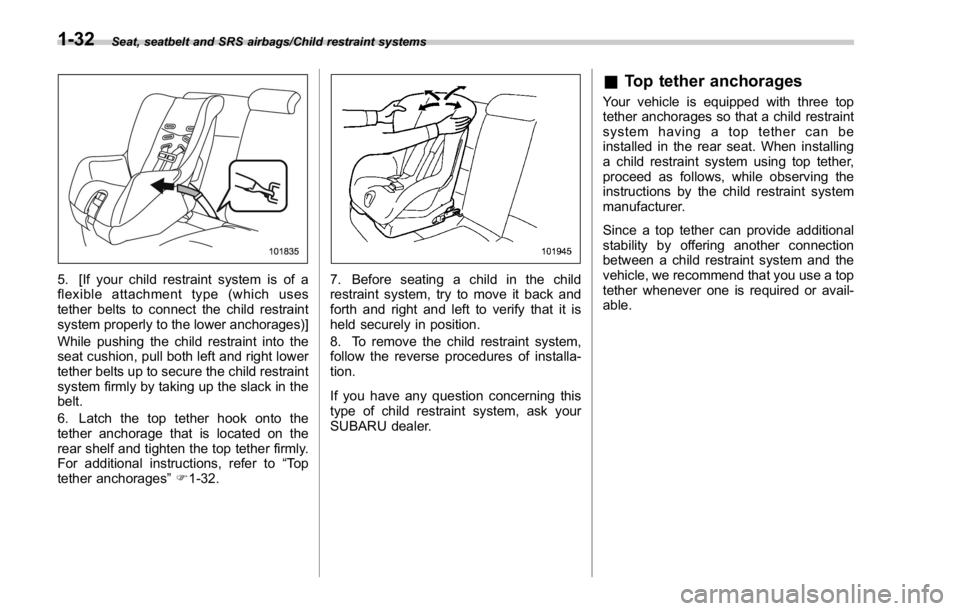
Seat, seatbelt and SRS airbags/Child restraint systems
5. [If your child restraint system is of a
flexible attachment type (which uses
tether belts to connect the child restraint
system properly to the lower anchorages)]
While pushing the child restraint into the
seat cushion, pull both left and right lower
tether belts up to secure the child restraint
system firmly by taking up the slack in the
belt.
6. Latch the top tether hook onto the
tether anchorage that is located on the
rear shelf and tighten the top tether firmly.
For additional instructions, refer to “ To p
tether anchorages ” F 1-32. 7. Before seating a child in the child
restraint system, try to move it back and
forth and right and left to verify that it is
held securely in position.
8. To remove the child restraint system,
follow the reverse procedures of installa-
tion.
If you have any question concerning this
type of child restraint system, ask your
SUBARU dealer. & Top tether anchorages Your vehicle is equipped with three top
tether anchorages so that a child restraint
system having a top tether can be
installed in the rear seat. When installing
a child restraint system using top tether,
proceed as follows, while observing the
instructions by the child restraint system
manufacturer.
Since a top tether can provide additional
stability by offering another connection
between a child restraint system and the
vehicle, we recommend that you use a top
tether whenever one is required or avail-
able.1-32
Page 62 of 594
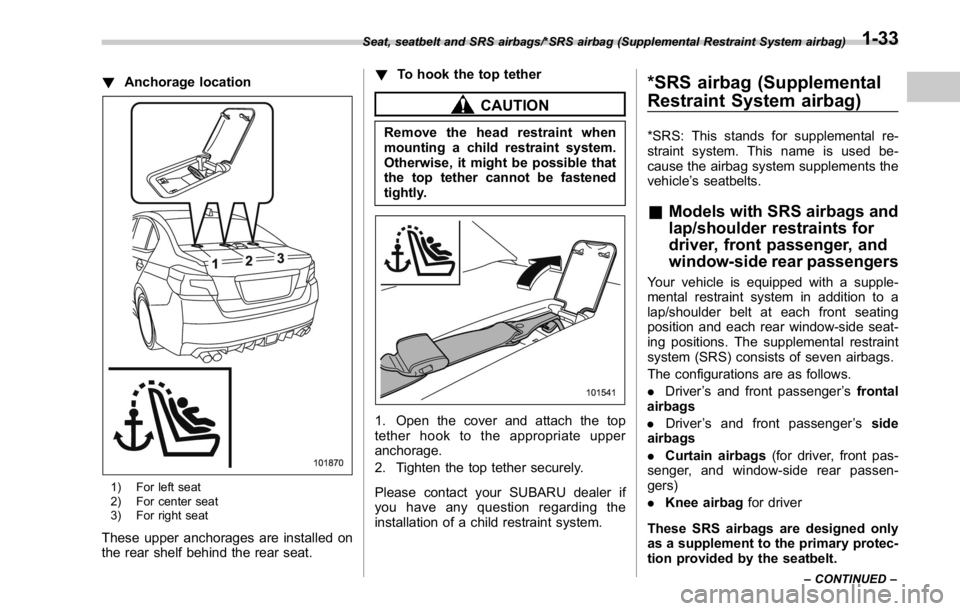
! Anchorage location
1) For left seat
2) For center seat
3) For right seat
These upper anchorages are installed on
the rear shelf behind the rear seat. ! To hook the top tether
CAUTIONRemove the head restraint when
mounting a child restraint system.
Otherwise, it might be possible that
the top tether cannot be fastened
tightly.
1. Open the cover and attach the top
tether hook to the appropriate upper
anchorage.
2. Tighten the top tether securely.
Please contact your SUBARU dealer if
you have any question regarding the
installation of a child restraint system. *SRS airbag (Supplemental
Restraint System airbag) *SRS: This stands for supplemental re-
straint system. This name is used be-
cause the airbag system supplements the
vehicle ’ s seatbelts.
& Models with SRS airbags and
lap/shoulder restraints for
driver, front passenger, and
window-side rear passengers Your vehicle is equipped with a supple-
mental restraint system in addition to a
lap/shoulder belt at each front seating
position and each rear window-side seat-
ing positions. The supplemental restraint
system (SRS) consists of seven airbags.
The configurations are as follows.
. Driver ’ s and front passenger ’ s frontal
airbags
. Driver ’ s and front passenger ’ s side
airbags
. Curtain airbags (for driver, front pas-
senger, and window-side rear passen-
gers)
. Knee airbag for driver
These SRS airbags are designed only
as a supplement to the primary protec-
tion provided by the seatbelt.Seat, seatbelt and SRS airbags/*SRS airbag (Supplemental Restraint System airbag)
– CONTINUED –1-33
Page 63 of 594
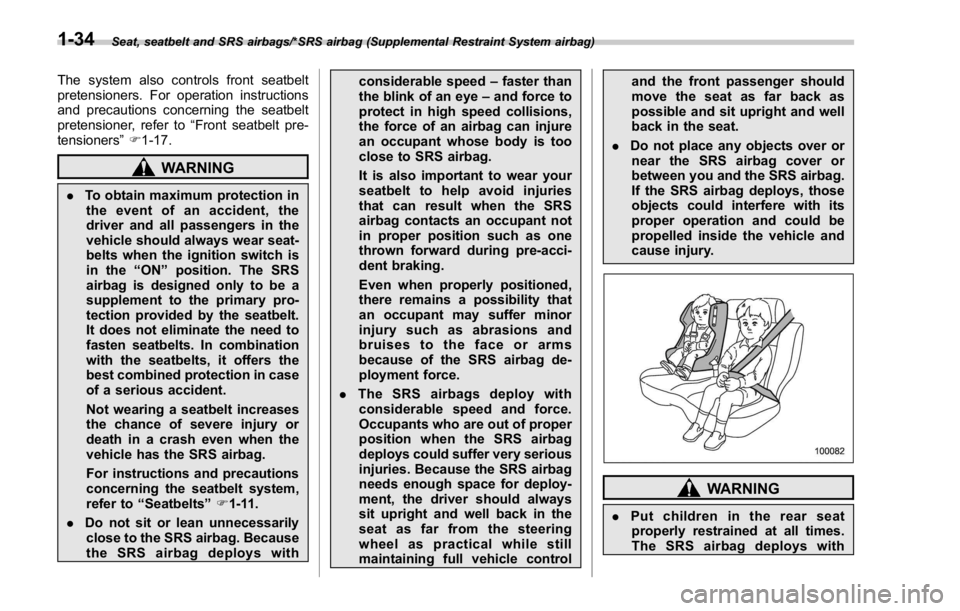
Seat, seatbelt and SRS airbags/*SRS airbag (Supplemental Restraint System airbag)
The system also controls front seatbelt
pretensioners. For operation instructions
and precautions concerning the seatbelt
pretensioner, refer to “ Front seatbelt pre-
tensioners ” F 1-17.
WARNING. To obtain maximum protection in
the event of an accident, the
driver and all passengers in the
vehicle should always wear seat-
belts when the ignition switch is
in the “ ON ” position. The SRS
airbag is designed only to be a
supplement to the primary pro-
tection provided by the seatbelt.
It does not eliminate the need to
fasten seatbelts. In combination
with the seatbelts, it offers the
best combined protection in case
of a serious accident.
Not wearing a seatbelt increases
the chance of severe injury or
death in a crash even when the
vehicle has the SRS airbag.
For instructions and precautions
concerning the seatbelt system,
refer to “ Seatbelts ” F 1-11.
. Do not sit or lean unnecessarily
close to the SRS airbag. Because
the SRS airbag deploys with considerable speed – faster than
the blink of an eye – and force to
protect in high speed collisions,
the force of an airbag can injure
an occupant whose body is too
close to SRS airbag.
It is also important to wear your
seatbelt to help avoid injuries
that can result when the SRS
airbag contacts an occupant not
in proper position such as one
thrown forward during pre-acci-
dent braking.
Even when properly positioned,
there remains a possibility that
an occupant may suffer minor
injury such as abrasions and
bruises to the face or arms
because of the SRS airbag de-
ployment force.
. The SRS airbags deploy with
considerable speed and force.
Occupants who are out of proper
position when the SRS airbag
deploys could suffer very serious
injuries. Because the SRS airbag
needs enough space for deploy-
ment, the driver should always
sit upright and well back in the
seat as far from the steering
wheel as practical while still
maintaining full vehicle control and the front passenger should
move the seat as far back as
possible and sit upright and well
back in the seat.
. Do not place any objects over or
near the SRS airbag cover or
between you and the SRS airbag.
If the SRS airbag deploys, those
objects could interfere with its
proper operation and could be
propelled inside the vehicle and
cause injury.
WARNING
. Put children in the rear seat
properly restrained at all times.
The SRS airbag deploys with1-34
Page 64 of 594
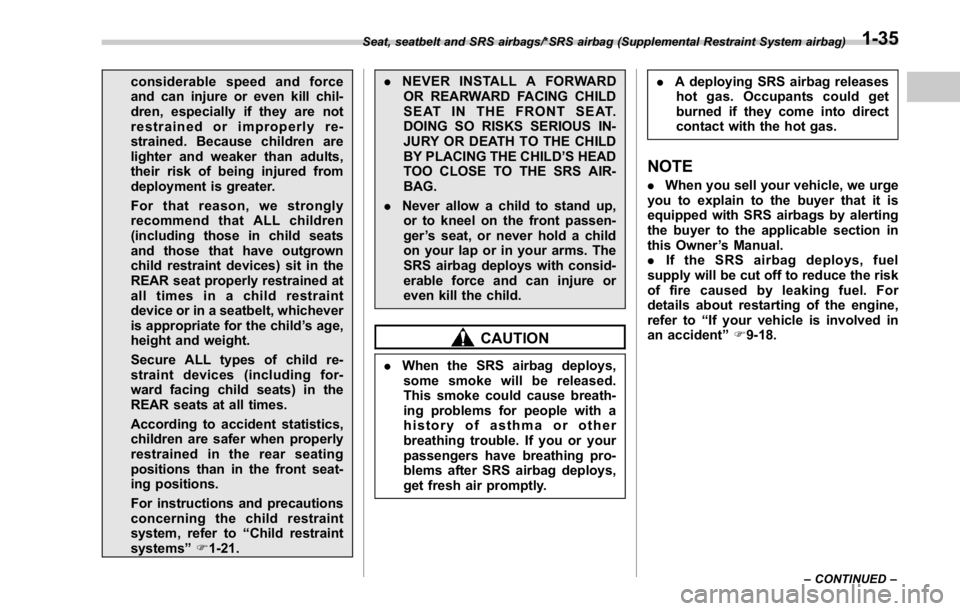
considerable speed and force
and can injure or even kill chil-
dren, especially if they are not
restrained or improperly re-
strained. Because children are
lighter and weaker than adults,
their risk of being injured from
deployment is greater.
For that reason, we strongly
recommend that ALL children
(including those in child seats
and those that have outgrown
child restraint devices) sit in the
REAR seat properly restrained at
all times in a child restraint
device or in a seatbelt, whichever
is appropriate for the child ’ s age,
height and weight.
Secure ALL types of child re-
straint devices (including for-
ward facing child seats) in the
REAR seats at all times.
According to accident statistics,
children are safer when properly
restrained in the rear seating
positions than in the front seat-
ing positions.
For instructions and precautions
concerning the child restraint
system, refer to “ Child restraint
systems ” F 1-21. . NEVER INSTALL A FORWARD
OR REARWARD FACING CHILD
SEAT IN THE FRONT SEAT.
DOING SO RISKS SERIOUS IN-
JURY OR DEATH TO THE CHILD
BY PLACING THE CHILD ’ S HEAD
TOO CLOSE TO THE SRS AIR-
BAG.
. Never allow a child to stand up,
or to kneel on the front passen-
ger ’ s seat, or never hold a child
on your lap or in your arms. The
SRS airbag deploys with consid-
erable force and can injure or
even kill the child.
CAUTION. When the SRS airbag deploys,
some smoke will be released.
This smoke could cause breath-
ing problems for people with a
history of asthma or other
breathing trouble. If you or your
passengers have breathing pro-
blems after SRS airbag deploys,
get fresh air promptly. . A deploying SRS airbag releases
hot gas. Occupants could get
burned if they come into direct
contact with the hot gas.
NOTE . When you sell your vehicle, we urge
you to explain to the buyer that it is
equipped with SRS airbags by alerting
the buyer to the applicable section in
this Owner ’ s Manual.
. If the SRS airbag deploys, fuel
supply will be cut off to reduce the risk
of fire caused by leaking fuel. For
details about restarting of the engine,
refer to “ If your vehicle is involved in
an accident ” F 9-18.Seat, seatbelt and SRS airbags/*SRS airbag (Supplemental Restraint System airbag)
– CONTINUED –1-35
Page 65 of 594
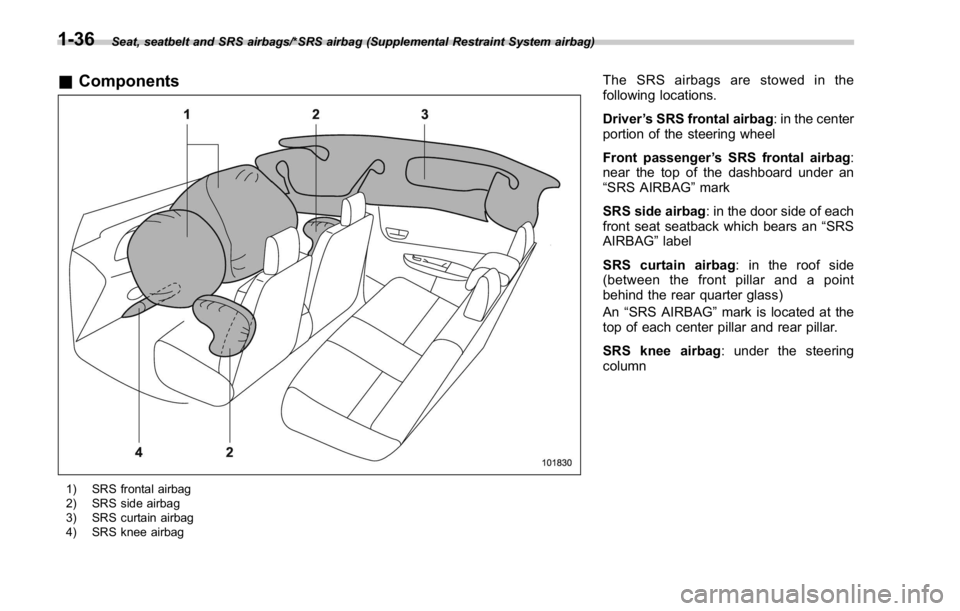
Seat, seatbelt and SRS airbags/*SRS airbag (Supplemental Restraint System airbag)
& Components
1) SRS frontal airbag
2) SRS side airbag
3) SRS curtain airbag
4) SRS knee airbag The SRS airbags are stowed in the
following locations.
Driver ’ s SRS frontal airbag : in the center
portion of the steering wheel
Front passenger ’ s SRS frontal airbag :
near the top of the dashboard under an
“ SRS AIRBAG ” mark
SRS side airbag : in the door side of each
front seat seatback which bears an “ SRS
AIRBAG ” label
SRS curtain airbag : in the roof side
(between the front pillar and a point
behind the rear quarter glass)
An “ SRS AIRBAG ” mark is located at the
top of each center pillar and rear pillar.
SRS knee airbag : under the steering
column1-36
Page 66 of 594
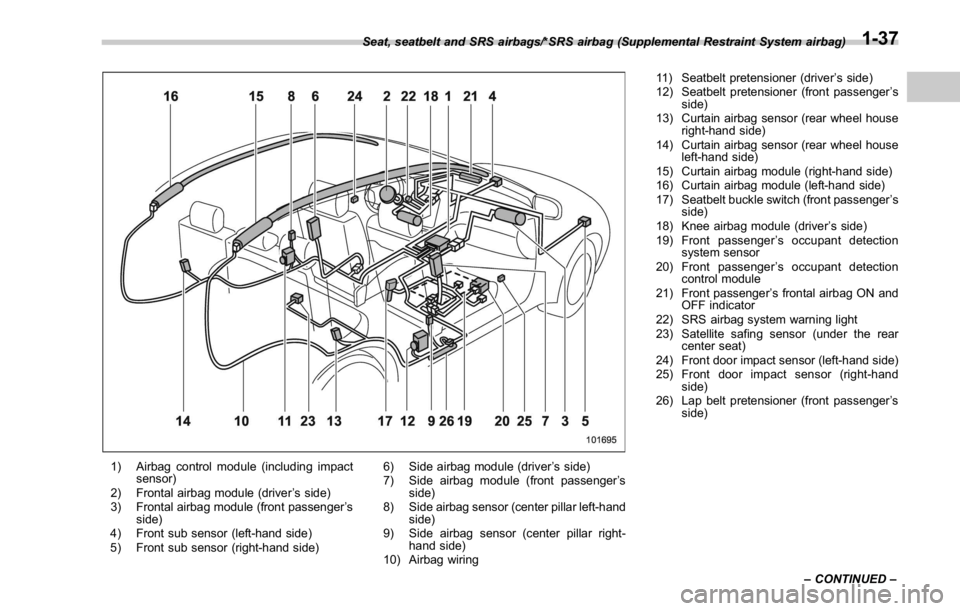
1) Airbag control module (including impact
sensor)
2) Frontal airbag module (driver ’ s side)
3) Frontal airbag module (front passenger ’ s
side)
4) Front sub sensor (left-hand side)
5) Front sub sensor (right-hand side) 6) Side airbag module (driver ’ s side)
7) Side airbag module (front passenger ’ s
side)
8) Side airbag sensor (center pillar left-hand
side)
9) Side airbag sensor (center pillar right-
hand side)
10) Airbag wiring 11) Seatbelt pretensioner (driver ’ s side)
12) Seatbelt pretensioner (front passenger ’ s
side)
13) Curtain airbag sensor (rear wheel house
right-hand side)
14) Curtain airbag sensor (rear wheel house
left-hand side)
15) Curtain airbag module (right-hand side)
16) Curtain airbag module (left-hand side)
17) Seatbelt buckle switch (front passenger ’ s
side)
18) Knee airbag module (driver ’ s side)
19) Front passenger ’ s occupant detection
system sensor
20) Front passenger ’ s occupant detection
control module
21) Front passenger ’ s frontal airbag ON and
OFF indicator
22) SRS airbag system warning light
23) Satellite safing sensor (under the rear
center seat)
24) Front door impact sensor (left-hand side)
25) Front door impact sensor (right-hand
side)
26) Lap belt pretensioner (front passenger ’ s
side)Seat, seatbelt and SRS airbags/*SRS airbag (Supplemental Restraint System airbag)
– CONTINUED –1-37
Page 67 of 594
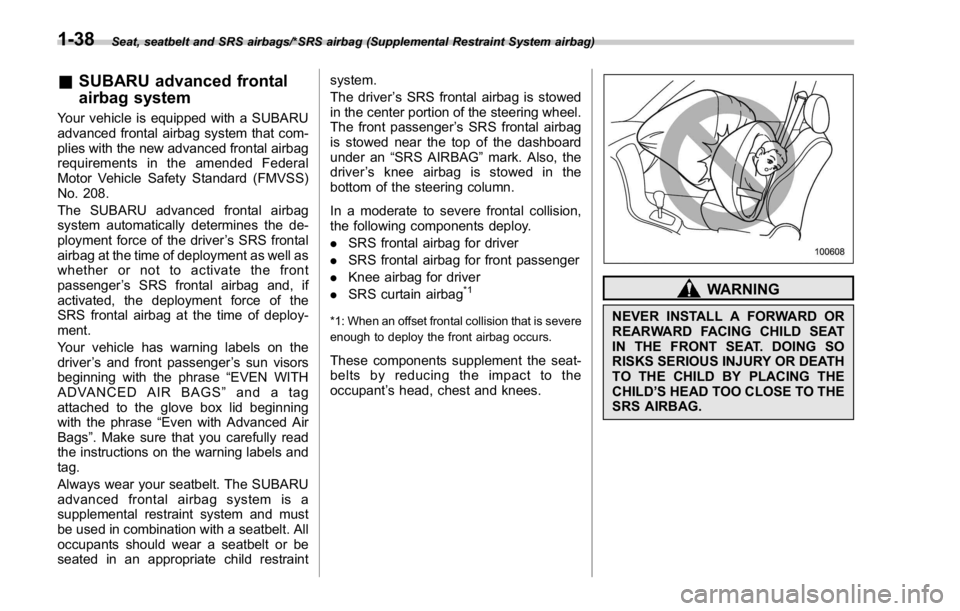
Seat, seatbelt and SRS airbags/*SRS airbag (Supplemental Restraint System airbag)
& SUBARU advanced frontal
airbag systemYour vehicle is equipped with a SUBARU
advanced frontal airbag system that com-
plies with the new advanced frontal airbag
requirements in the amended Federal
Motor Vehicle Safety Standard (FMVSS)
No. 208.
The SUBARU advanced frontal airbag
system automatically determines the de-
ployment force of the driver ’ s SRS frontal
airbag at the time of deployment as well as
whether or not to activate the front
passenger ’ s SRS frontal airbag and, if
activated, the deployment force of the
SRS frontal airbag at the time of deploy-
ment.
Your vehicle has warning labels on the
driver ’ s and front passenger ’ s sun visors
beginning with the phrase “ EVEN WITH
ADVANCED AIR BAGS ” and a tag
attached to the glove box lid beginning
with the phrase “ Even with Advanced Air
Bags ” . Make sure that you carefully read
the instructions on the warning labels and
tag.
Always wear your seatbelt. The SUBARU
advanced frontal airbag system is a
supplemental restraint system and must
be used in combination with a seatbelt. All
occupants should wear a seatbelt or be
seated in an appropriate child restraint system.
The driver ’ s SRS frontal airbag is stowed
in the center portion of the steering wheel.
The front passenger ’ s SRS frontal airbag
is stowed near the top of the dashboard
under an “ SRS AIRBAG ” mark. Also, the
driver ’ s knee airbag is stowed in the
bottom of the steering column.
In a moderate to severe frontal collision,
the following components deploy.
. SRS frontal airbag for driver
. SRS frontal airbag for front passenger
. Knee airbag for driver
. SRS curtain airbag *1
*1: When an offset frontal collision that is severe
enough to deploy the front airbag occurs.
These components supplement the seat-
belts by reducing the impact to the
occupant ’ s head, chest and knees. WARNINGNEVER INSTALL A FORWARD OR
REARWARD FACING CHILD SEAT
IN THE FRONT SEAT. DOING SO
RISKS SERIOUS INJURY OR DEATH
TO THE CHILD BY PLACING THE
CHILD ’ S HEAD TOO CLOSE TO THE
SRS AIRBAG.1-38
Page 68 of 594
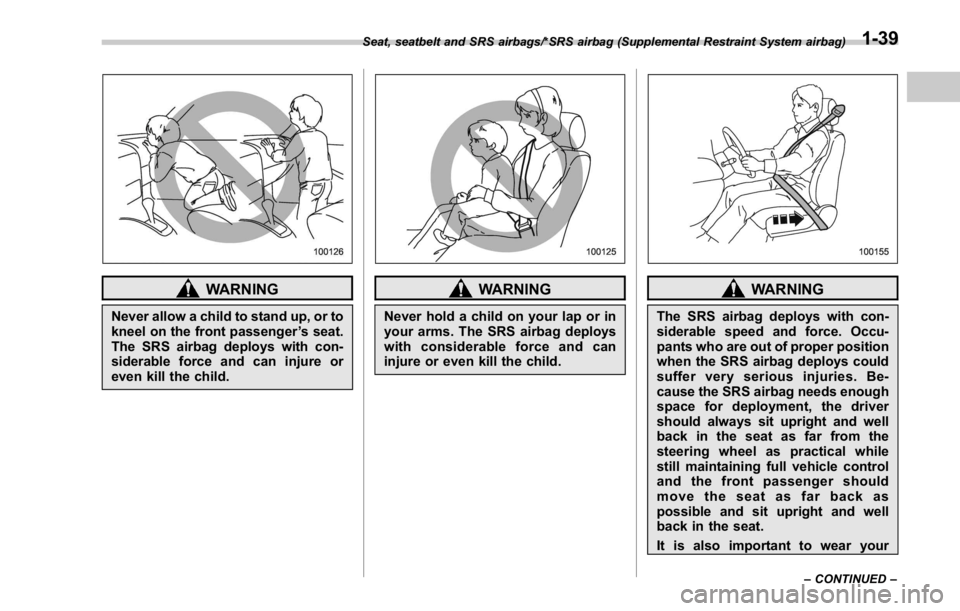
WARNINGNever allow a child to stand up, or to
kneel on the front passenger ’ s seat.
The SRS airbag deploys with con-
siderable force and can injure or
even kill the child. WARNINGNever hold a child on your lap or in
your arms. The SRS airbag deploys
with considerable force and can
injure or even kill the child. WARNINGThe SRS airbag deploys with con-
siderable speed and force. Occu-
pants who are out of proper position
when the SRS airbag deploys could
suffer very serious injuries. Be-
cause the SRS airbag needs enough
space for deployment, the driver
should always sit upright and well
back in the seat as far from the
steering wheel as practical while
still maintaining full vehicle control
and the front passenger should
move the seat as far back as
possible and sit upright and well
back in the seat.
It is also important to wear yourSeat, seatbelt and SRS airbags/*SRS airbag (Supplemental Restraint System airbag)
– CONTINUED –1-39
Page 69 of 594
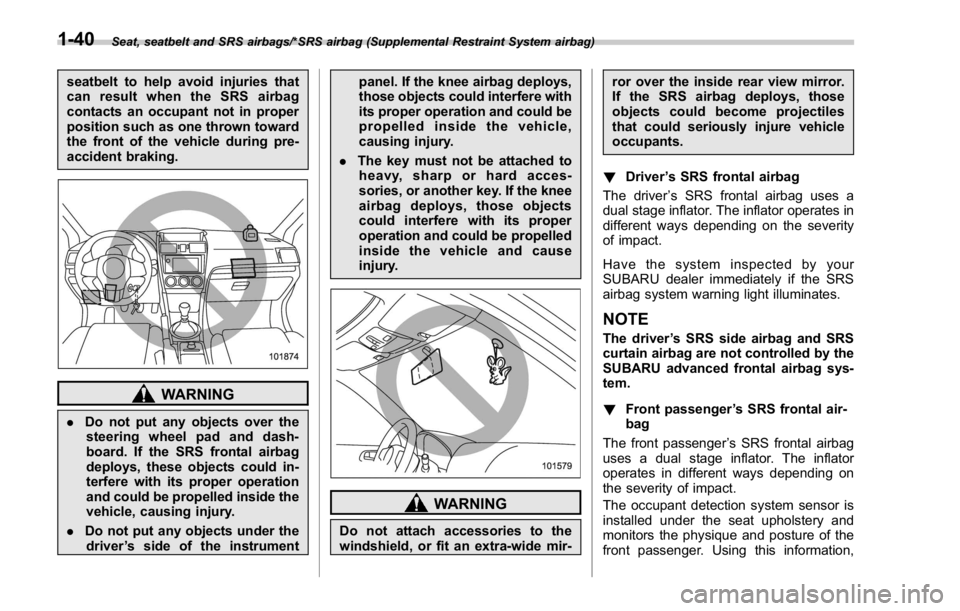
Seat, seatbelt and SRS airbags/*SRS airbag (Supplemental Restraint System airbag)
seatbelt to help avoid injuries that
can result when the SRS airbag
contacts an occupant not in proper
position such as one thrown toward
the front of the vehicle during pre-
accident braking.
WARNING
. Do not put any objects over the
steering wheel pad and dash-
board. If the SRS frontal airbag
deploys, these objects could in-
terfere with its proper operation
and could be propelled inside the
vehicle, causing injury.
. Do not put any objects under the
driver ’ s side of the instrument panel. If the knee airbag deploys,
those objects could interfere with
its proper operation and could be
propelled inside the vehicle,
causing injury.
. The key must not be attached to
heavy, sharp or hard acces-
sories, or another key. If the knee
airbag deploys, those objects
could interfere with its proper
operation and could be propelled
inside the vehicle and cause
injury.
WARNING
Do not attach accessories to the
windshield, or fit an extra-wide mir- ror over the inside rear view mirror.
If the SRS airbag deploys, those
objects could become projectiles
that could seriously injure vehicle
occupants.
! Driver ’ s SRS frontal airbag
The driver ’ s SRS frontal airbag uses a
dual stage inflator. The inflator operates in
different ways depending on the severity
of impact.
Have the system inspected by your
SUBARU dealer immediately if the SRS
airbag system warning light illuminates.
NOTE The driver ’ s SRS side airbag and SRS
curtain airbag are not controlled by the
SUBARU advanced frontal airbag sys-
tem.
! Front passenger ’ s SRS frontal air-
bag
The front passenger ’ s SRS frontal airbag
uses a dual stage inflator. The inflator
operates in different ways depending on
the severity of impact.
The occupant detection system sensor is
installed under the seat upholstery and
monitors the physique and posture of the
front passenger. Using this information,1-40
Page 70 of 594
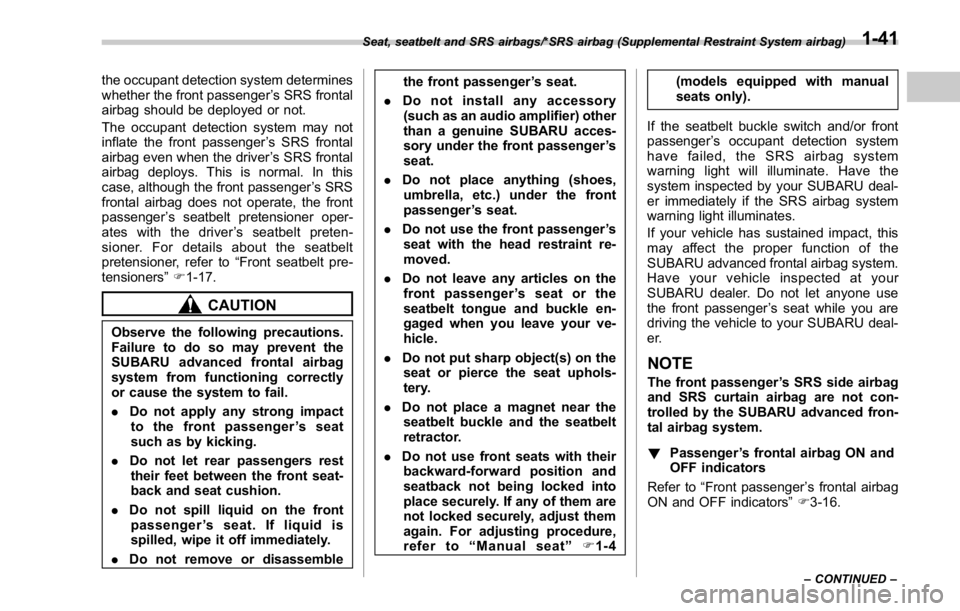
the occupant detection system determines
whether the front passenger ’ s SRS frontal
airbag should be deployed or not.
The occupant detection system may not
inflate the front passenger ’ s SRS frontal
airbag even when the driver ’ s SRS frontal
airbag deploys. This is normal. In this
case, although the front passenger ’ s SRS
frontal airbag does not operate, the front
passenger ’ s seatbelt pretensioner oper-
ates with the driver ’ s seatbelt preten-
sioner. For details about the seatbelt
pretensioner, refer to “ Front seatbelt pre-
tensioners ” F 1-17.
CAUTIONObserve the following precautions.
Failure to do so may prevent the
SUBARU advanced frontal airbag
system from functioning correctly
or cause the system to fail.
. Do not apply any strong impact
to the front passenger ’ sseat
such as by kicking.
. Do not let rear passengers rest
their feet between the front seat-
back and seat cushion.
. Do not spill liquid on the front
passenger ’ s seat. If liquid is
spilled, wipe it off immediately.
. Do not remove or disassemble the front passenger ’ s seat.
. Do not install any accessory
(such as an audio amplifier) other
than a genuine SUBARU acces-
sory under the front passenger ’ s
seat.
. Do not place anything (shoes,
umbrella, etc.) under the front
passenger ’ s seat.
. Do not use the front passenger ’ s
seat with the head restraint re-
moved.
. Do not leave any articles on the
front passenger ’ s seat or the
seatbelt tongue and buckle en-
gaged when you leave your ve-
hicle.
. Do not put sharp object(s) on the
seat or pierce the seat uphols-
tery.
. Do not place a magnet near the
seatbelt buckle and the seatbelt
retractor.
. Do not use front seats with their
backward-forward position and
seatback not being locked into
place securely. If any of them are
not locked securely, adjust them
again. For adjusting procedure,
refer to “ Manual seat ” F 1-4 (models equipped with manual
seats only).
If the seatbelt buckle switch and/or front
passenger ’ s occupant detection system
have failed, the SRS airbag system
warning light will illuminate. Have the
system inspected by your SUBARU deal-
er immediately if the SRS airbag system
warning light illuminates.
If your vehicle has sustained impact, this
may affect the proper function of the
SUBARU advanced frontal airbag system.
Have your vehicle inspected at your
SUBARU dealer. Do not let anyone use
the front passenger ’ s seat while you are
driving the vehicle to your SUBARU deal-
er.
NOTE The front passenger ’ s SRS side airbag
and SRS curtain airbag are not con-
trolled by the SUBARU advanced fron-
tal airbag system.
! Passenger ’ s frontal airbag ON and
OFF indicators
Refer to “ Front passenger ’ s frontal airbag
ON and OFF indicators ” F 3-16.Seat, seatbelt and SRS airbags/*SRS airbag (Supplemental Restraint System airbag)
– CONTINUED –1-41